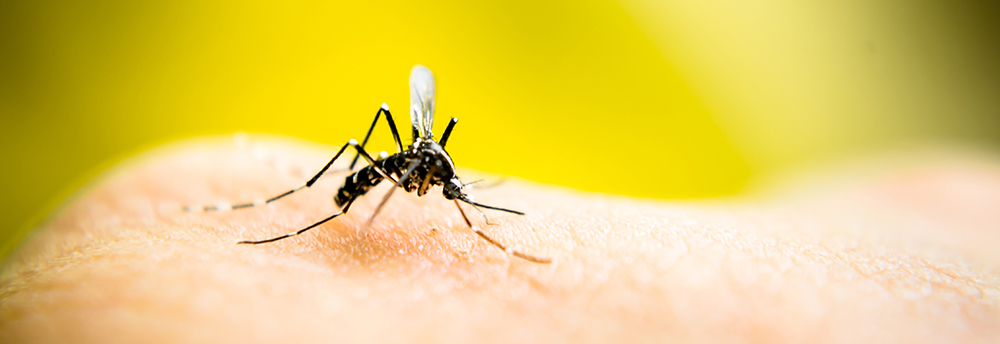INSPECTION
If you’re dealing with a mosquito problem, chances are there isn’t much inspection needing to be done because if you’re getting bit, they’ve found you before you’ve found them. But what is more important in this phase is being able to pinpoint where the mosquitos are hiding and where their breeding grounds are and finding their eggs and larvae.
Check places where there is standing water. Mosquitoes require water to lay eggs and breed. Interestingly enough, the reproductive cycle for a mosquito is primarily aquatic as they eggs in the water hatch and move into the larvae and adult stage while in water.
Check where there has been watered gathered from rainfall or water left in pet dishes, bird baths, puddles etc.
CONTROL
There is a variety of options for controlling mosquitoes. Options include installing a Mosquito Misting System in your backyard, foggers and perimeter spray. How you decide to handle your mosquito problems will depend on how much you want to spend and your particular property.
The recommended process to get rid of mosquitoes from your property effectively is 1) Sanitation 2)Removing areas where there is standing water to discourage breeding areas and 3) using insecticide products. Following the control plan we have laid out is guaranteed to significantly reduce mosquitoes on your property and will allow you to enjoy the outdoors and evenings without the constant threat of mosquitoes. Just to note: There is no guaranteed method to completely eradicate mosquitoes and in fact it is not realistic to believe that treatment products will 100% control the mosquito population on your property completely, but our program can bring mosquitos down to a manageable level by creating deterrences and making it unsavory for mosquitos to hang around your home.
STEP 1: SANITATION
- Before getting into chemical usage, you can take practical steps to eliminate the appeal of your property to mosquitoes as a breeding ground.
- Remove weeds and tall grassy areas around your home to help reduce mosquitoes harborage areas.
- Clean and pick up any unnecessary clutter and yard debris around your home that may pick up water when it rains.
- Leave yard lights off when possible to avoid attracting mosquitos unnecessarily. You can even try to use less attractive lights such as sodium lights in your yard at night.
- Ensure that window and door screens fit properly. Repair or replace any screens with holes or tears.
- Remember: It is not always your yard that is the issue.
STEP 2: ELIMINATE POTENTIAL BREEDING AREAS (STANDING WATER)
- Get rid of old tires, buckets, aluminum cans, or any kind of item that can serve as a container for holding water. Dump out accumulated water from trash cans, boats, wheelbarrows, pet dishes, and flowering pots.
- Remove any standing water on flat roofs or any part of your home that can create puddles.
- Replace water in birdbaths and wading pools at least once a week and keep swimming pools properly cleaned and chlorinated. Mosquitoes prefer quiet, non-flowing water for egg-laying and development so for things like fountains, you can add mosquito eating fish to the water to deter mosquitos and create movement in the water.
- Irrigate lawns and gardens carefully to prevent water from standing for several days.
STEP 3: APPLY LARVACIDE
- Areas where you cannot control standing water, you can apply larvicide. Larvicide is a sort of growth control that prevents larvae from maturing into adult mosquitoes. Common places to apply larvicide are places where water doesn’t freely flow like containerized ponds, animal watering troughs, flowering pots etc.
STEP 4: APPLY INSECTICIDE TO YOUR YARD
- One option is to apply a residual insecticide and Insect Growth Regulator in a hose end sprayer or backpack sprayer. This would be a product that you mix with water and offers a safe product to use on your lawn and plantings.
- When controlling mosquitos in this method you will want to really get good coverage and spray the underneath of the leaves of the plants, this is where some of the species of biting mosquitoes will rest during the day. This is a very inexpensive control method that will get you quite a bit of mosquito relief but will require constant applications and retreats about every 14 days or once a month.
- Using a mosquito fogger is a great option if you are willing to spend a little more cash. Foggers are available in backpack blowers, electrical handheld units and then upwards of the larger truck mounted commercial units.Foggers can be used in conjunction with perimeter spraying
- If you live in a high mosquito breeding zone, like the south, spraying all the foliage and then fogging the open areas every couple weeks or when you know you will be having an outdoor event is recommended. This combination of mosquito control will really amaze you as to how effective these two technique are to control mosquitoes.
PREVENTION
- You can help prevent pesky and potentially dangerous disease-carrying mosquitoes from infesting on your property through preventative measures which includes sanitation and preventative insecticide treatments.
SANITATION:
- Keep your grass short by mowing regularly
- Prune trees and bushes to reduce shade and allow more sunlight in the yard
- Empty containers that fill with rainwater
- Remove yard clutter
INSECTICIDE APPLICATIONS:
- Regular perimeter sprayings as noted in the control section is recommended to keep mosquitoes away and reduce their population and makes your property less appealing for them to gather at.
- Places where rainwater gathers and you are unable to dump it out should be treated with a larvicide as noted in the Control section as well.
Article Courtesy of: Solutions Pest and Lawn

